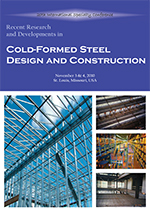Session Dates
03 Nov 2010
Abstract
A series of experiments on the lateral tors ional instability of single channels is presented. The channels are restrained by a purlin – angle cleat connection and subjected to a two point loading system in order to simulate a distributed load. Failure of the channels occurred by local buckling of the compression zone of the flange and web and lateral torsional buckling of the channels between points of lateral support. Tests have shown the purlin–angle cleat connection to be capable of restraining the frames from failing due to lateral-torsional buckling. This eliminates the idea of having fly-bracings, which is normally done in practice to restrain torsional instability.
Department(s)
Civil, Architectural and Environmental Engineering
Research Center/Lab(s)
Wei-Wen Yu Center for Cold-Formed Steel Structures
Meeting Name
20th International Specialty Conference on Cold-Formed Steel Structures
Publisher
Missouri University of Science and Technology
Document Version
Final Version
Rights
© 2010 Missouri University of Science and Technology, All rights reserved.
Document Type
Article - Conference proceedings
File Type
text
Language
English
Recommended Citation
Bukasa, G. M. and Masce, M. Dundu, "Lateral Torsional Instability of Single Channels Restrained by Angle Cleats" (2010). CCFSS Proceedings of International Specialty Conference on Cold-Formed Steel Structures (1971 - 2018). 6.
https://scholarsmine.mst.edu/isccss/20iccfss/20iccfss-session5/6
Lateral Torsional Instability of Single Channels Restrained by Angle Cleats
A series of experiments on the lateral tors ional instability of single channels is presented. The channels are restrained by a purlin – angle cleat connection and subjected to a two point loading system in order to simulate a distributed load. Failure of the channels occurred by local buckling of the compression zone of the flange and web and lateral torsional buckling of the channels between points of lateral support. Tests have shown the purlin–angle cleat connection to be capable of restraining the frames from failing due to lateral-torsional buckling. This eliminates the idea of having fly-bracings, which is normally done in practice to restrain torsional instability.



